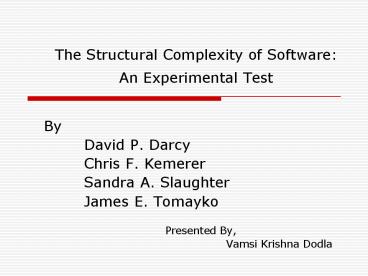The Structural Complexity of Software: An Experimental Test - PowerPoint PPT Presentation
1 / 17
Title:
The Structural Complexity of Software: An Experimental Test
Description:
Sandra A. Slaughter. James E. Tomayko. Presented By, Vamsi Krishna Dodla ... This model considers tasks to have three essential concepts: products, required ... – PowerPoint PPT presentation
Number of Views:332
Avg rating:3.0/5.0
Title: The Structural Complexity of Software: An Experimental Test
1
The Structural Complexity of Software
An Experimental Test
- By
- David P. Darcy
- Chris F. Kemerer
- Sandra A. Slaughter
- James E. Tomayko
- Presented By,
-
Vamsi Krishna Dodla
2
AIM Objective
- The main aim of this research is to examine the
structural complexity of software and
specifically, the potential interaction of the
two dominant dimensions of structural complexity,
coupling and cohesion. - The objective of this paper is to understand how
software design decisions affect the structural
complexity of software.
3
Introduction
- This paper focuses on structural complexity
because structural complexity primarily expends
intellectual resources. - This paper is not about proposing new measures,
but, rather focusing attention more directly on
coupling and cohesion as essential and
interrelated indicators of the underlying
dimensions of structural complexity.
4
Background
- Two theoretical perspectives are employed in
order to develop a theoretically-based model for
the research. - 1.Woods task complexity model.
- 2.software complexity.
5
Woods Task Complexity Model
- This model considers tasks to have three
essential concepts products, required acts and
information cues. - Products are entities created or produced by
behaviors. - Act is the pattern of behaviors with some
identifiable purpose or direction. - Information cues are pieces of information about
the attributes of stimulus objects.
6
- Three sources of task complexity are defined
based on the above concepts - Component complexity is defined as a function of
the number of distinct acts that need to be
executed in the performance of the task. - Coordinate complexity covers the nature of
relationships between task inputs and task
products. - Dynamic complexity refers to the changes in the
states of the world which have an effect on the
relationships between tasks and products.
7
Cohesion coupling
- A measure of the extent to which related aspects
of a system are kept together in the same module,
and unrelated aspects are kept out is called
cohesion. - A measure of the extent to which
interdependencies exist between software modules
is called coupling.
8
Coupling and cohesion as dimensions of structural
complexity of software
- Component complexity is a function of each of the
distinct acts and the information cues that must
be attended to and processed for each act. - In the software domain, an act is a program unit
and information cues are the data tokens specific
to that program unit. - Cohesion is an inverse indicator of complexity in
that the more cohesive a program unit is the less
complex that program unit is considered to be and
the lower the effort required to maintain it.
9
- Coordinate complexity is a function of the
precedence relations for the act, summed across
all of the acts required to complete the task. - Coupling measures the relatedness of a program
unit to other program units. For a given program
unit, a greater relatedness to other program
units increases the complexity of that program
unit and consequently the effort required to
maintain it.
10
Research Model for the Structural Complexity of
Software
11
Research design
- To test the model proposed a controllable lab
experimental design was chosen to maximize the
casual inferences that can be made from the
results. - Participants attempted two perfective software
maintenance tasks - one task was performed under the procedural
programming paradigm using the C programming
language and the other under OO paradigm using
C . - Efforts are measured in terms of the total length
of the time to complete both tasks without errors.
12
- For each of the two tasks, there are four
variants where each variant corresponds to a cell -
cohesion(coh) - Coupling(cpl)
13
Total task time (Effort)
- The participants utilized a tsk timer running on
their pcs that recorded how long they took to
complete the task. - The task effort was a combination of the two task
times. - Covariates
- A no of individual factors can potentially impact
effort. These include previous programming
experience in terms of the length of experience,
breadth of experience and general ability.
14
- Procedure
- results
15
Limitations
- We have studied a single type of task. It may be
that other types of maintenance will best suit a
different model. - Only a limited set of internal software
attributes have been studied in this paper.
16
Conclusion
- Though this paper focused on effort, the
literature has discussed other dimensions,
including quality. - It would be valuable to extend this work to other
aspects of comprehension performance and under a
wider range of contexts, such as corrective
maintenance.
17
- THANK YOU





























![AMSc Research Methods Research approach IV: Experimental [1] PowerPoint PPT Presentation](https://s3.amazonaws.com/images.powershow.com/8084663.th0.jpg?_=20160828056)
